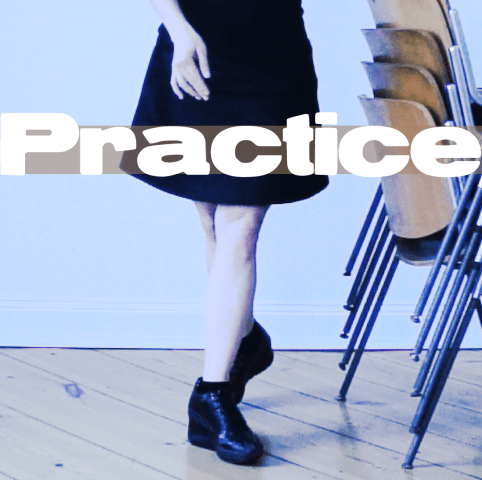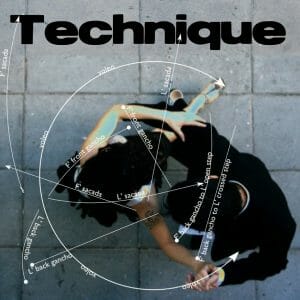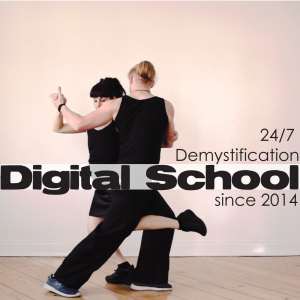by Nick Young
In this musicality session, we look at choosing which beats of the music to step on. First we identify the beats we have to work with, and then we try some simple ideas for dancing them. These ideas are simple ways to make your dance more interesting and enjoyable!
The previous session was about how to skip beats. This session is about which beats to skip and which beats to step.
Throughout this session, whenever you skip a beat, remember you can use any of the techniques from the previous session (for example!) to give it a different feeling: pausing, slow-motion, or punctuated.
Tango and dancing to the beat
- Tango is notable amongst partner dances in having no fixed rhythm – you can step on (or between) any beats you like.
- The good news: you never have to keep time with a fixed rhythm!
- The bad news: you can’t just keep time with a fixed rhythm!
- So, you can choose any beats to any rhythm you like, but you must actually choose. You cannot simply react.
- There are infinite rhythms you could choose to dance. That’s a bit overwhelming. So here are some very simple ideas…
Basic technique
- When using beats and rhythm as the foundation for your musicality, it becomes crucially important to be able to hit the beat you choose with each step.
- Typically, it feels most satisfying to hit the exact moment of the beat somewhere between contacting the ground with your new base leg, and full transfer of weight onto your new base leg.
- Recall the basic technique for all steps in tango: flexion (of current base leg), projection (of free leg), extension (of current base leg) and transfer of weight (onto free leg/new base leg).
- That means that most of the work for step (flexion and projection) has to happen before the beat you want to hit!
- Practice simply walking and hitting the beat (any beat, so long as it’s the one you intend!). Recognise that you start the movement well in advance of the beat – maybe a half-beat early – but you have the control to contact the ground/transfer weight exactly on the beat, not falling early or lagging behind.
- This comes back to a fundamental part of musicality: your body (and your partner!) cannot react to a beat after you hear it. You must choose the beat and prepare with deliberate intention.
Identifying beats
- Start by simply tapping out the regular beat of your favourite music.
- The beat is always regular – equal time duration between every beat – like clockwork, regardless of what’s happening in the melody.
- Sometimes a beat might be silent, but usually it’ll be marked by a regular pulse in the music.
- Here’s the tricky part: there’s really no absolutely correct way to say that this pulse of sound is a “beat” and that pulse of sound is not a “beat”.
- Why? Because even when we successfully pick out a regular pulse as the beat, it’s always possible to subdivide that into smaller half-beats or quarter-beats.
- Think of drums in rock music – are the slower drums the beat, or are the faster high-hats the beat?
- It’s even trickier in tango music, which uses nothing as reliable as drums for the beat!
- The good news is, as a dancer you don’t really need to worry about what is the “correct” beat. All you have to do is identify the regular pulse that’s closest to normal walking tempo, and call that the beat.
- Any faster pulses in between the walking-tempo beat, we’ll call half-beats and quarter-beats. We’ll worry about them later.
- This regular, walking-tempo beat is called “single-time”. It’s what we would step on by default in tango.
- “Half-time” means stepping half as frequently (more slowly). Not to be confused with “half-beats” which are half as long (therefore faster).
- “Quarter-time” means stepping one quarter as frequently (very slowly).
Identifying bars
- Most music will be arranged into bars of 2 or 4 regular beats.
- Traditional tango is usually arranged in bars of 2 beats.
- Pop music is usually arranged in bars of 4 beats.
- We’ll assume 4 beats, because for our purposes, you can treat two bars of 2 beats as a 4-beat bar anyway.
- Ignore 3-beats per bar music for now! (waltz, vals)
- Try to identify the bars in your favourite music by counting out the beat:
- | 1 2 3 4 | 1 2 3 4 | 1 2 3 4 |
- Hints for identifying bars:
- A stronger pulse on the first beat of the bar
- A chord change on the first beat of the bar
- An obvious repeating pattern (drums, bassline, melody)
- The first and third beats of the bar should feel stronger than the second and fourth beats of the bar.
- Count out the beat as “ONE-two-THREE-four”:
- | 1 2 3 4 | 1 2 3 4 | 1 2 3 4 |
- Even though the second and fourth beats are weaker, they’re still strong and we would still make a step on them at regular walking tempo while dancing.
- Count out the beat as “ONE-two-THREE-four”:
- The first beat is the strongest of them all, because in addition to being a stronger pulse, it usually also marks the start of a new melody or chord for that bar.
Single-time
- | 1 2 3 4 | 1 2 3 4 | 1 2 3 4 |
- At normal waking tempo, we would step on every beat in the bar.
- For short passages of music this can feel very powerful and deliberate, but if you step every beat for the whole song, it will feel very monotonous.
Half-time
- | 1 2 3 4 | 1 2 3 4 | 1 2 3 4 |
- One way of expressing musicality is simply to skip every second beat.
- The obvious choice is to skip the weaker second and fourth beats (2 + 4), and step on the stronger first and third beats (1 + 3).
- Use any of the ideas from the previous session to skip these beats.
- This also makes it easier on you – more time to think about each step and prepare
- (remember that most of the work of each step – flexion and projection – must happen before the beat hits!)
- Decorations in tango music often occur around the 4th beat of the bar. If you’re skipping the 2nd and 4th beat by pausing, you highlight the decoration in the music and allow the revel to perform an adorno in response to it.
Quarter-time
- | 1 2 3 4 | 1 2 3 4 | 1 2 3 4 |
- A very strong way of expressing the music: only step one out of four beats.
- Because the first beat of the bar is often the start of a new melodic idea in the music, stepping only the first beat and pausing for the rest of the bar can give space in your dance for greater appreciation of the music.
- For example, in a traditional tango song, it’s common to pause during the first bar of vocals to honour the singer and recognise the change of feeling when the lyrics are introduced.
- Pausing for the entire remainder of the bar gives the revel ample opportunity to perform adornos, if the music suggests it.
Contrast and Progression
- | 1 2 3 4 | 1 2 3 4 | 1 2 3 4 |
- Contrast is an important part of dance (and music and art in general). Here’s one idea for using contrast to make even simple walking steps feel inspired.
- It’s common in songs, especially “ballad” pop songs, to have a progression of intensity.
- For example, a low intensity introduction, a medium intensity verse, and a high intensity chorus.
- The tempo – the duration of the beats – is the same, but the instrumentation becomes increasingly layered and the beats become more strongly marked. Beats (or half-beats) that might have been silent in low-intensity sections become voiced in high-intensity sections, giving the impression of a faster beat.
- This contrast in intensity can also be found in tango songs, though not tied to verse and chorus the same way as pop songs.
- Listen for sharp, intense pulses on the beat in some phrases, compared to sweeping strings or vocals in other phrases.
- Many traditional tango songs have a “variacion” section at the very end. It is the same tempo, but the beats are marked very intensely and the melody relentlessly hits many notes per beat, giving the impression of much greater tempo (even though it’s actually the same).
- Try matching the tempo of your steps (quarter-time, half-time, or single-time) with the intensity of the music. As a guide, just to try it out:
- For pop songs:
- low-intensity intro/break = | 1 2 3 4 | (quarter-time steps)
- medium-intensity verse = | 1 2 3 4 | (half-time steps)
- high-intensity chorus = | 1 2 3 4 | (single-time steps)
- For tango songs:
- sweeping strings/vocals = | 1 2 3 4 | (quarter-time steps)
- regular pulses = | 1 2 3 4 | (half-time steps)
- crazy variacion = | 1 2 3 4 | (single-time steps)
- When skipping some beats (quarter-time and half-time), remember to use any/all of the techniques from the previous musicality session, so it doesn’t feel stiff:
- Pausing (come to a rest on one foot, but play with gentle movements like boleos and adornos while pausing)
- Slow-motion (drag out the entire step over the multiple “skipped” beats, play with the space in between steps)
- Punctuated (step sharply on the beat but as soon as you hit it, drag out the extension, collection, and flexion, winding up tension for the next explosive step)
- For pop songs:
- Contrast slow, half- or quarter-time dancing against normal single-time to make even normal single-time feel intense!
- If you just dance single-time the whole song, it will feel boring, and even feel slow.
- But if you use contrast by dancing some sections half-time and especially quarter-time, then when you return to single-time for the more intense sections, what previously felt boring now feels powerful, deliberate, relentless.
- By making the dance easier on yourself (dancing slowly to some sections), you also make the dance more impressive!
- Using a progression of quarter-time to half-time to single-time, matched to the progression of the music (maybe easier to predict in verse-chorus structure of pop songs), feels especially dramatic!
Syncopation
- More advanced!
- Very briefly (because it’s an incredibly rich topic) – syncopation is emphasising what would normally be off beat (e.g. a half-beat) or a weak beat (e.g. 2 or 4).
- Half-time syncopation
- | 1 2 3 4 | 1 2 3 4 | 1 2 3 4 |
- Recall that when stepping in half-time, we usually skip the weak beats (2 + 4) and step on the strong beats (1 + 3).
- Some music – notably rock music – places a very strong emphasis on those weak beats (2 + 4) – e.g. in rock music, this corresponds to the snare drum or clapping.
- Try stepping on the syncopated weak beats sometimes, instead of the usual obvious strong beats. Count the beats out as “PAUSE-step-PAUSE-step”.
- Try dancing most sections normally but dance some syncopated to create contrast.
- Single-time syncopation
- | 1 • 2 • 3 • 4 • | 1 • 2 • 3 • 4 • | 1 • 2 • 3 • 4 • |
- Both tango and pop music usually give some pulse in between the walking-tempo beats.
- These half-beat pulses are almost always weaker than the full beats (e.g. the weak high-hat on the half-beat vs. the bass/snare drum on the full beat)
- Count out the beat as “ONE-and-two-and-THREE-and-four-and…”
- | 1 • 2 • 3 • 4 • | 1 • 2 • 3 • 4 • | 1 • 2 • 3 • 4 • |
- the “ands” are the half-beats in between the full beats.
- the ONE and THREE full beats are still stronger than the two and four
- We commonly use these half-beats to dance some steps in double-time – which we’ll cover in a future session – just mentioning for now.
- Very rarely the music will emphasise the half-beats more strongly than the full beats.
- | 1 • 2 • 3 • 4 • | 1 • 2 • 3 • 4 • | 1 • 2 • 3 • 4 • |
- E.g. listen to the beginning of D’Arienzo’s “El Apronte” (the loud violin bows are syncopated) and the last quarter of Pugliese’s “Pata Ancha” (the deep heavy piano strikes are syncopated).
- When you hear this syncopation being emphasised try dancing single-time, but instead of stepping on the usual full beat, step on the strongly syncopated half-beat.
- It’s rare, and difficult, but very satisfying when you catch it!













